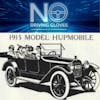The Rise and Fall of Hupp Motorcar 278 SHORT NaPodPoMo

The Hupp Motor Company, a serious carmaker with a whimsical name, emerged from the ambition of Robert Craig Hupp. Born in Grand Rapids and raised in Detroit, Hupp's journey began at Olds Motor Works and continued at Ford Motor Company, where he honed his skills on the Model K.
Leaving Ford in 1907, Hupp set out to create a lightweight car tailored for American roads. With funds from J. Walter Drake, Joseph R. Drake, and John E. Baker, the Hupp Motor Car Company was born in 1908. As capital dwindled, Charles D. Hastings stepped in to finance a prototype for the upcoming Detroit Auto Show.
On a frigid night, snow drifting into their makeshift workspace, Hupp and Hastings feverishly completed their masterpiece: the two-seater Huppmobile Model 20. At its debut on February 15, 1909, the car garnered enough interest and $50 deposits to raise $25,000 and propel the company into production.
From rented factories to larger facilities, production soared from 1,618 cars in 1909 to 12,543 by 1913. The Huppmobile's reputation for affordability and reliability led to its selection as Detroit's first police cars.
A bold marketing stunt saw three men drive a Huppmobile around the world from November 10, 1910 to January 24, 1912. The 49,000-mile journey captured imaginations worldwide and solidified the Huppmobile as a global export. This heroic journey was covered in the book "Three Men in a Hupp: Around the World by Automobile, 1910-1912" by James A. Ward, link in the show notes.
However, two critical factors hampered success. First, Hupp ceased production of their lightweight model; secondly, he sold his stock and left his company in September 1911 due to differing visions.
Hupp started other car ventures without achieving similar success; most notably the Hupp Yates Electric Car Company with his brother Lewis. After legal disputes and rebranding to RCH Company, Hupp eventually joined Monarch Motor Car Company. By 1920, electric cars had lost popularity, and the RCH Hupp Yates was discontinued.
Meanwhile, the Hupp Motor Car Company continued to expand its operations, creating a legacy that would endure for over three decades.
The automaker's sales swelled like a tidal wave; from 15,000 units in 1921 to a staggering 65,000 by 1928. In a bid to capture the founder's magic, Hump Motor launched a cross-country odyssey on August 28, 1916. The Humpmobile Model N danced through all 48 state capitals, traversing 18,430 miles over four months.
Robert Hupp's flame was extinguished on December 7, 1931, at age 55. Only to prove Bobby right, the company forged ahead into luxury, only to crumble under the weight of bankruptcy on November 1, 1940. Sales peaked in 1928 but quickly plummeted to around 17,500 in 1931.
Resurrected as Hupp Incorporated in 1941, the company shifted its focus from cars to air conditioning and heating units. The old Hupp facility passed through various hands until it was demolished in '80-'81, giving way to General Motors' Poletown plant.
#cars #car #collectorcars #cartalk #carhistory #automotivehistory #automobile #thisdayinautomotivehistory #thisdayinhistory #classiccars #hupmobile #aaca #NaPosPoMo




